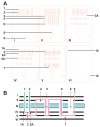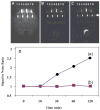Lab-on-a-chip for botulinum neurotoxin a (BoNT-A) activity analysis
- PMID: 19865736
- PMCID: PMC2849933
- DOI: 10.1039/b912097a
Lab-on-a-chip for botulinum neurotoxin a (BoNT-A) activity analysis
Abstract
A Lab-on-a-chip (LOC) was designed, fabricated and tested for the in vitro detection of botulinum neurotoxin serotype A (BoNT-A) activity using an assay that measures cleavage of a fluorophore-tagged peptide substrate specific for BoNT-A (SNAP-25) by the toxin light chain (LcA). LcA cleavage was detected by Förster Resonance Energy Transfer (FRET) fluorescence. FRET fluorescence was measured by a newly developed portable charge-coupled device (CCD) fluorescent detector equipped with multi-wavelength light-emitting diodes (LED) illumination. An eight V-junction microchannel device for BoNTs activity assays was constructed using Laminated Object Manufacturing (LOM) technology. The six-layer device was fabricated with a Poly(methyl methacrylate (PMMA) core and five polycarbonate (PC) layers micromachined by CO2 laser. The LOC is operated by syringe and is equipped with reagents, sample wells, reaction wells, diffusion traps (to avoid cross contamination among channels) and waste reservoirs. The system was detected LcA at concentrations as low as 0.5 nM, which is the reported sensitivity of the SNAP-25 in vitro cleavage assay. Combined with our CCD detector, the simple point of care system enables the detection of BoNTs activity and may be useful for the performance of other complex medical assays without a laboratory. This approach may realize the potential to enhance the quality of health care delivery for underserved populations.
Figures





Similar articles
-
Charged-coupled device (CCD) detectors for Lab-on-a Chip (LOC) optical analysis.Methods Mol Biol. 2013;949:365-85. doi: 10.1007/978-1-62703-134-9_23. Methods Mol Biol. 2013. PMID: 23329454
-
ELISA-LOC: lab-on-a-chip for enzyme-linked immunodetection.Lab Chip. 2010 Aug 21;10(16):2093-100. doi: 10.1039/c003994b. Epub 2010 Jun 11. Lab Chip. 2010. PMID: 20544092
-
Lensless CCD-based fluorometer using a micromachined optical Söller collimator.Lab Chip. 2011 Mar 7;11(5):941-9. doi: 10.1039/c0lc00431f. Epub 2011 Jan 17. Lab Chip. 2011. PMID: 21243150
-
A graphene oxide based fluorescence resonance energy transfer (FRET) biosensor for ultrasensitive detection of botulinum neurotoxin A (BoNT/A) enzymatic activity.Biosens Bioelectron. 2015 Mar 15;65:238-44. doi: 10.1016/j.bios.2014.10.050. Epub 2014 Oct 23. Biosens Bioelectron. 2015. PMID: 25461164
-
Mass Spectrometric Detection of Bacterial Protein Toxins and Their Enzymatic Activity.Toxins (Basel). 2015 Aug 31;7(9):3497-511. doi: 10.3390/toxins7093497. Toxins (Basel). 2015. PMID: 26404376 Free PMC article. Review.
Cited by
-
Optical imaging techniques for point-of-care diagnostics.Lab Chip. 2013 Jan 7;13(1):51-67. doi: 10.1039/c2lc40864c. Epub 2012 Oct 9. Lab Chip. 2013. PMID: 23044793 Free PMC article. Review.
-
Image stacking approach to increase sensitivity of fluorescence detection using a low cost complementary metal-oxide-semiconductor (CMOS) webcam.Sens Actuators B Chem. 2012;171-172:141-147. doi: 10.1016/j.snb.2012.02.003. Sens Actuators B Chem. 2012. PMID: 23990697 Free PMC article.
-
An automated point-of-care system for immunodetection of staphylococcal enterotoxin B.Anal Biochem. 2011 Sep 1;416(1):74-81. doi: 10.1016/j.ab.2011.05.014. Epub 2011 May 17. Anal Biochem. 2011. PMID: 21640067 Free PMC article.
-
Sensing the deadliest toxin: technologies for botulinum neurotoxin detection.Toxins (Basel). 2010 Jan;2(1):24-53. doi: 10.3390/toxins2020024. Epub 2010 Jan 7. Toxins (Basel). 2010. PMID: 22069545 Free PMC article.
-
Electrical percolation-based biosensor for real-time direct detection of staphylococcal enterotoxin B (SEB).Biosens Bioelectron. 2010 Aug 15;25(12):2573-8. doi: 10.1016/j.bios.2010.04.019. Epub 2010 Apr 21. Biosens Bioelectron. 2010. PMID: 20447819 Free PMC article.
References
-
- Yager P, Edwards T, Fu E, Helton K, Nelson K, Tam MR, Weigl BH. Nature. 2006;442:412–418. - PubMed
-
- Cai S, Singh BR, Sharma S. Crit Rev Microbiol. 2007;33:109–125. - PubMed
-
- CDC. Botulism in the United States 1899–1996: Handbook for Epidemiologists, Clinicians, and Laboratory Workers. Centers for Disease Control and Prevention; Atlanta, Ga: 1998.
-
- Keller JE. Neuroscience. 2006
MeSH terms
Substances
Grants and funding
LinkOut - more resources
Full Text Sources
Other Literature Sources
Medical
Research Materials
Miscellaneous

